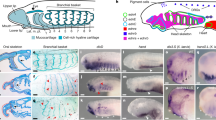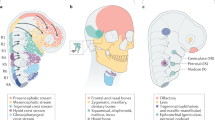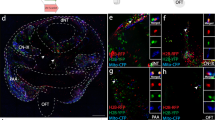Abstract
Endothelin receptor B (EDNRB) is a G-protein-coupled receptor with seven transmembrane domains which is required for the development of melanocytes and enteric neurons. Mice that are homozygous for a null mutation in the Ednrb gene are almost completely white and die as juveniles from megacolon. To determine when EDNRB signalling is required during embryogenesis, we have exploited the tetracycline-inducible system to generate strains of mice in which the endogenous Ednrb locus is under the control of the tetracycline-dependant transactivators tTa or rtTA. By using this system to express Ednrb at different stages of embryogenesis, we have determined that EDNRB is required during a restricted period of neural crest development between embryonic days 10 and 12.5. Moreover, our results imply that EDNRB is required for the migration of both melanoblasts and enteric neuroblasts.
This is a preview of subscription content, access via your institution
Access options
Subscribe to this journal
Receive 51 print issues and online access
$199.00 per year
only $3.90 per issue
Buy this article
- Purchase on Springer Link
- Instant access to full article PDF
Prices may be subject to local taxes which are calculated during checkout





Similar content being viewed by others
References
Le Douarin,N. M. The Neural Crest (Cambridge Univ. Press, Cambridge, 1982).
Anderson,D. J. et al. Cell lineage determination and the control of neuronal identity in the neural crest. Cold Spring Harb. Symp. Quant. Biol. 62, 493–504 (1997).
Silvers,W. K. The Coat Colors of Mice: A Model for Mammalian Gene Action and Interaction (Springer, New York, 1979).
Barsh,G. S. The genetics of pigmentation: from fancy genes to complex traits. Trends Genet. 12, 299–305 (1996).
Hosoda,K. et al. Targeted and natural (piebald-lethal) mutations of endothelin-B receptor gene produce megacolon associated with spotted coat color in mice. Cell 79, 1267–1276 (1994).
Baynash,A. G. et al. Interaction of endothelin-3 with endothelin-B receptor is essential for development of epidermal melanocytes and enteric neurons. Cell 79, 1277–1285 ( 1994).
Bedell,M. A., Largaespada,D. A., Jenkins, N. A. & Copeland,N. G. Mouse models of human disease. Part II: recent progress and future directions. Genes Dev. 11, 11–43 (1997).
Jackson,I. J. Homologous pigmentation mutations in human, mouse and other model organisms. Hum. Mol. Genet. 6, 1613– 1624 (1997).
Pavan,W. J. & Tilghman,S. M. Piebald lethal (sl) acts early to disrupt the development of neural crest-derived melanocytes. Proc. Natl Acad. Sci. USA 91, 7159– 7163 (1994).
Lahav,R., Ziller,C., Dupin,E. & Le Douarin,N. M. Endothelin 3 promotes neural crest cell proliferation and mediates a vast increase in melanocyte number in culture. Proc. Natl Acad. Sci. USA 93, 3892–3892 (1996).
Reid,K. et al. Multiple roles for endothelin in melanocyte development: regulation of progenitor number and stimulation of differentiation. Development 122, 3911–3919 ( 1996).
Yoshida,H., Kunisada,T., Kusakabe,M., Nishikawa,S. & Nishikawa, S. I. Distinct stages of melanocyte differentiation revealed by analysis of nonuniform pigmentation patterns. Development 122, 1207–1214 (1996).
Schneuwly,S., Klemenz,R. & Gehring, W. J. Redesigning the body plan of Drosophila by ectopic expression of the homeotic gene Antennapedia. Nature 325, 816–818 (1987).
Fischer,J. A., Giniger,E., Maniatis,T. & Ptashne,M. GAL4 activates transcription in Drosophila. Nature 332, 853–856 (1988).
Gingrich,J. R. & Roder,J. Inducible gene expression in the nervous system of transgenic mice. Annu. Rev. Neurosci. 21, 377–405 ( 1998).
Gossen,M. & Bujard,H. Tight control of gene expression in mammalian cells by tetracycline- responsive promoters. Proc. Natl Acad. Sci. USA 89, 5547–5551 (1992).
Gossen,M. et al. Transcriptional activation by tetracyclines in mammalian cells. Science 268, 1766–1769 (1995).
Furth,P. A. et al. Temporal control of gene expression in transgenic mice by a tetracycline-responsive promoter. Proc. Natl Acad. Sci. USA 91, 9302–9306 (1994).
Kistner,A. et al. Doxycycline-mediated quantitative and tissue-specific control of gene expression in transgenic mice. Proc. Natl Acad. Sci. USA 93, 10933–10938 ( 1996).
Mayford,M. et al. Control of memory formation through regulated expression of a CaMKII transgene. Science 274, 1678– 1683 (1996).
Ewald,D. et al. Time-sensitive reversal of hyperplasia in transgenic mice expressing SV40 T antigen. Science 273, 1384– 1386 (1996).
Mansuy,I. M. et al. Inducible and reversible gene expression with the rtTA system for the study of memory. Neuron 21, 257– 265 (1998).
Rossant,J. & McMahon,A. “Cre”-ating mouse mutants—a meeting review on conditional mouse genetics. Genes Dev. 13, 142–145 (1999).
Dixon,R. A. et al. Structural features required for ligand binding to the beta-adrenergic receptor. EMBO J. 6, 3269– 3275 (1987).
Lakso,M. et al. Efficient in vivo manipulation of mouse genomic sequences at the zygote stage. Proc. Natl Acad. Sci. USA 93, 5860–5865 (1996).
Shin,M. K., Russell,L. B. & Tilghman, S. M. Molecular characterization of four induced alleles at the Ednrb locus. Proc. Natl Acad. Sci. USA 94, 13105–13110 (1997).
Baron,U. et al. Generation of conditional mutants in higher eukaryotes by switching between the expression of two genes. Proc. Natl Acad. Sci. USA 96, 1013–1018 ( 1999).
Serbedzija,G. N., Fraser,S. E. & Bronner-Fraser, M. Pathways of trunk neural crest cell migration in the mouse embryo as revealed by vital dye labelling. Development 108, 605–612 (1990).
Steel,K. P., Davidson,D. R. & Jackson, I. J. TRP-2/DT, a new early melanoblast marker, shows that steel growth factor (c-kit ligand) is a survival factor. Development 115, 1111–1119 ( 1992).
Wehrle-Haller,B. & Weston,J. A. Soluble and cell-bound forms of steel factor activity play distinct roles in melanocyte precursor dispersal and survival on the lateral neural crest migration pathway. Development 121, 731–742 (1995).
Nakayama,A. et al. Mutations in microphthalmia, the mouse homolog of the human deafness gene MITF, affect neuroepithelial and neural crest-derived melanocytes differently. Mech. Dev. 70, 155– 166 (1998).
Pachnis,V., Mankoo,B. & Costantini, F. Expression of the c-ret proto-oncogene during mouse embryogenesis. Development 119, 1005– 1017 (1993).
Mackenzie,M. A., Jordan,S. A., Budd,P. S. & Jackson,I. J. Activation of the receptor tyrosine kinase Kit is required for the proliferation of melanoblasts in the mouse embryo. Dev. Biol. 192, 99– 107 (1997).
Mayer,T. C. The migratory pathway of neural crest cells into the skin of mouse embryos. Dev. Biol. 34, 39–46 (1973).
Newgreen,D. F. & Hartley,L. Extracellular matrix and adhesive molecules in the early development of the gut and its innervation in normal and spotting lethal rat embryos. Acta Anat. (Basel) 154, 243–260 (1995).
Kapur,R. P., Sweetser,D. A., Doggett,B., Siebert,J. R. & Palmiter,R. D. Intercellular signals downstream of endothelin receptor-B mediate colonization of the large intestine by enteric neuroblasts. Development 121, 3787– 3795 (1995).
Hearn,C. J., Murphy,M. & Newgreen, D. GDNF and ET-3 differentially modulate the numbers of avian enteric neural crest cells and enteric neurons in vitro. Dev. Biol. 197, 93–105 ( 1998).
Wu,J. J., Chen,J. X., Rothman,T. P. & Gershon,M. D. Inhibition of in vitro enteric neuronal development by endothelin-3: mediation by endothelin B receptors. Development 126 , 1161–1173 (1999).
Leibl,M. A. et al. Expression of endothelin 3 by mesenchymal cells of embryonic mouse caecum. Gut 44, 246– 252 (1999).
Kuhn,R., Rajewsky,K. & Muller, W. Generation and analysis of interleukin-4 deficient mice. Science 254, 707–710 (1991).
Jones,B. K., Levorse,J. M. & Tilghman, S. M. Igf2 imprinting does not require its own DNA methylation or H19 RNA. Genes Dev. 12, 2200– 2207 (1998).
Swiatek,P. J. & Gridley,T. Perinatal lethality and defects in hindbrain development in mice homozygous for a targeted mutation of the zinc finger gene Krox20. Genes Dev. 7, 2071– 2084 (1993).
Webber,A. L., Ingram,R. S., Levorse,J. M. & Tilghman,S. M. Location of enhancers is essential for the imprinting of H19 and Igf2 genes. Nature 391, 711–715 (1998).
Wilkinson,D. G. & Nieto,M. A. Detection of messenger RNA by in situ hybridization to tissue sections and whole mounts. Methods Enzymol. 225, 361–373 (1993).
Acknowledgements
We thank L. Henninghausen and H. Bujard for providing constructs; H. Westphal for providing EIIa-cre transgenic mice; the members of our laboratory for helpful discussions; and M. Cleary for critical comments on the manuscript. M.K.S. was a Jane Coffin Childs Postdoctoral Fellow and S.M.T. is an Investigator of the Howard Hughes Medical Institute. R.S.I. isolated and characterized the Ednrb genomic clones and J.M.L. injected the targeted ES cells into blastocysts. M.K.S. and S.M.T. were responsible for the design of the experiment and the writing of the manuscript, and M.K.S. for the generation of the targeting vectors, targeting of ES cells and analysing the mice.
Author information
Authors and Affiliations
Rights and permissions
About this article
Cite this article
Shin, M., Levorse, J., Ingram, R. et al. The temporal requirement for endothelin receptor-B signalling during neural crest development. Nature 402, 496–501 (1999). https://doi.org/10.1038/990040
Received:
Accepted:
Issue Date:
DOI: https://doi.org/10.1038/990040
This article is cited by
-
High incidence of EDNRB gene mutation in seven southern Chinese familial cases with Hirschsprung’s disease
Pediatric Surgery International (2024)
-
Genome-wide association and genotype by environment interactions for growth traits in U.S. Red Angus cattle
BMC Genomics (2022)
-
Zeb2/Axin2-Enriched BMSC-Derived Exosomes Promote Post-Stroke Functional Recovery by Enhancing Neurogenesis and Neural Plasticity
Journal of Molecular Neuroscience (2022)
-
Nerve-associated Schwann cell precursors contribute extracutaneous melanocytes to the heart, inner ear, supraorbital locations and brain meninges
Cellular and Molecular Life Sciences (2021)
-
Safety and Efficacy of Sovateltide (IRL-1620) in a Multicenter Randomized Controlled Clinical Trial in Patients with Acute Cerebral Ischemic Stroke
CNS Drugs (2021)
Comments
By submitting a comment you agree to abide by our Terms and Community Guidelines. If you find something abusive or that does not comply with our terms or guidelines please flag it as inappropriate.



